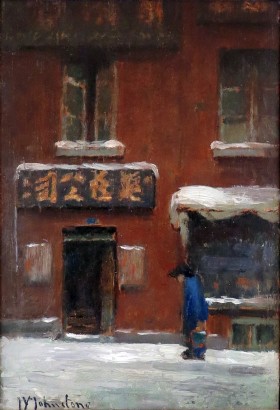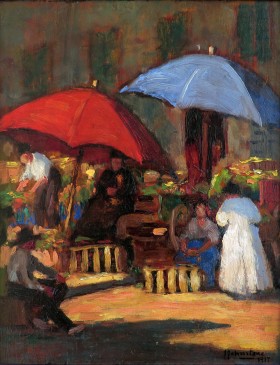John Young Johnstone: Myth and Modernism
From 1915, the beginning of John Young Johnstone's albeit too short mature career as an artist and through 1924 the National Gallery of Canada purchased six paintings by John Young Johnstone. In 1920 Quebec's Prime Minister Taschereau authorised the establishment of the Quebec Museum, to be opened two years forward. Under the Secretary of the province, The Honorable Athanase David, a jury was organized to select 6 paintings from the Art Association of Montreal and Royal Canadian Art exhibitions of that year to be the foundation for the future museum, one of which was Johnstone's Old Courtyard, St. Vincent Street [1] [2]. The following year, Montreal's La Presse, in their review of that now iconic Beaver Hall Group exhibition of 1921 held over at 305 Beaver Hall Hill, cited among the most interesting works in the exhibition a small painting by Johnstone of Rue des Carrieres calling it "a real gem" ("un vrai joyau") [3] [4]. The conclusion arrived at from the above is that in his day John Young Johnstone was an artist of distinction, one whose paintings stood out among those of his most accomplished peers.
The Chinese Shop, c. 1920
Oil on panel, 9 1/2 x 6 1/4 in (24.1 x 15.9 cm)
Recently sold by Alan Klinkhoff Gallery.
Bonsecour Market, July 1917
Oil on panel, 10 x 8 1/2 in.
Recently sold by Alan Klinkhoff Gallery.
The outstanding exhibition and accompanying catalogue 1920s Modernism in Montreal: The Beaver Hall Group, edited by Jacques Des Rochers and Brian Foss, provides an important and succinct summary of Johnstone's participation in Montreal's art community [5]. His formation and practice as an artist was very much in keeping with other aspiring and established artists of his place and time. This included studies at the Art Association of Montreal under William Brymner, then off to Paris, returning to Montreal where he contributed paintings to Art Association of Montreal spring shows as well as those of the Royal Canadian Academy of the Arts, membership in the Pen and Pencil Club, and the Arts Club of Montreal. Des Rochers and Foss disclose that Johnstone taught at various art schools, including the Monument National, the Arts Club and the Women's Art Association [6]. Johnstone was "expelled" from The Montreal Arts Club in 1928 [7]. The precise nature of the "information in the hands of the Council" that led to Johnstone's expulsion at their meeting of September 4 is not disclosed [8]. Sometime early in the year 1931 the Arts Club held a memorial exhibition in honour of this same expelled John Y. Johnstone. The May 8, 1931 Minutes of the Club's Council record a motion put forward by Robert Pilot "...that a letter embodying the thanks of the Club be forwarded to those who had so kindly loaned pictures for the John Y. Johnstone Exhibition" [9]. Curiously, we were unable to find record or announcement of the exhibition referenced in the minutes notes prior to the exhibition or any of the show itself.
Since so little is known about John Young Johnstone personally, the extraordinary but small body of his paintings where he finds composition in Montreal's Chinatown, has evoked a biography of mythical status. In September of 1998 our original family gallery, Galerie Walter Klinkhoff, celebrated our late father, Walter Klinkhoff, by putting together a tribute exhibition of outstanding paintings that Dad had sold over the years. The presentation included four small Johnstone oil sketches. In a review by Dorota Kozinska for the Montreal Gazette published in September 1998 Dorota wrote:
A query about four miniature paintings by John Y. Johnstone elicited an instant, abridged version of the short and violent life of the roguish, itinerant artist with a penchant for opium dens.
'He died in Cuba,' Eric Klinkhoff said, 'apparently killed in a duel over a woman.'
This bastard child of an English father and French-Canadian mother was one terrific painter, and his lifestyle was instrumental to a degree in the creation of these exquisite little oils.
Painted on what looks like the back of a cigar box, on average 5-by-6 inches, they attest to Johnstone's professional training and talent. They capture small fragments of life and landscape, intense and poetic, emanating an aura much larger than their size [10].
In her book The Beaver Hall Group and Its Legacy Evelyn Walters prefaces her entry on Johnstone with Eric's record of Johnstone's death in a duel, womanizing in Cuba. Then, she repeats stories of his "heavy drinking" that he is "rumoured to frequent Montreal's opium dens" and that he was a " bastard child," citing part of Dorota's Gazette review of our 1998 tribute exhibition [11]. Risking a perpetuation of a legend, she then cautions that some of the lore "create a man larger than life" and that some may be "fabrication" [12].
From the post William Watson Gallery era, we doubt if there was a commercial art gallery more active in reselling of Johnstone paintings than were we at Walter Klinkhoff Gallery. Indeed his story as we "knew" it was anecdotally that he was the illegitimate son of a prominent Montrealer, an Anglophone doctor perhaps, and a Francophone mother. She, his mother, lived on Île d'Orléans, explaining Johnstone's visits to the area. And, yes, he frequented Chinatown's opium dens and was killed in a duel in Cuba, a challenge over a woman. The origin of this anecdotal biography of "Johnny" Johnstone I do not recall. If my memory serves me correctly, around the time we did our Johnstone Retrospective exhibition, that is in the autumn of 2005, there was some additional mention of a girlfriend in Ottawa toward the end of his life. Again, like the rest of his story, it was all related second or maybe even third or fourth hand.
The benefit of research available in cyberspace and the splendid scholarship provided by the trained team of art curators led by Des Rocher and Foss and the supporting exhibition 1920s Modernism in Montreal: The Beaver Hall Group allows us to access information previously unavailable. We are now better able to consider or reconsider our previous hypotheses.
Still today little verifiable detail is known of the life of this enigmatic personality, John Young Johnstone. The Lovell Directories of Montreal for the years he contributed paintings to Art Association of Montreal and Royal Canadian Art exhibitions locate him living with his widowed mother Kate Johnstone at 233 Ontario Street West until 1920. Walters's description of him being a "bastard child" is, thus, unlikely. There is no evidence to suggest that "Kate" was French Canadian. Even the notion that he was itinerant, more so than perhaps other unmarried artists may not be accurate [13]. The same Montreal directories list him in a flat on University just north of the old Montreal High School, east of the main McGill University campus from 1920 until after 1928 and probably until he left for Cuba. With the same fixed address for the better part of 10 years until shortly before we know he died in Cuba might imply Johnstone more settled and stable than the vagabond others have suggested. His favoured identifiable Canadian painting places beyond Montreal appear to be primarily the Beaupré and Ile d'Orleans regions, ones captured in oils by numerous artists prior to him, Brymner and Cullen as examples. The facts surrounding his death at the relatively young age of 43 are unknown beyond the press reports of the day reading that he died in Havana after a brief illness [14]. Citing as a reference an unsubstantiated and brief report in Toronto’s Globe of February 14, 1930, ”Canadian Artist Dies In Poverty,“ Colin MacDonald in the often go to resource for biographies of Canadian artists writes in his entry for Johnstone, "In 1930 he went to Havana, Cuba and somehow became destitute and died there at the age of 43.” Adding to the intrigue MacDonald then concludes, “ Those who still enjoy his paintings wonder if his tragic ending could not have been prevented [15].” The Globe report and other similar ones published appear to be based on the same Canadian Press Dispatch.
The Johnstone retrospective at Galerie Walter Klinkhoff hosted was probably the largest exhibition of Johnstone's paintings. Our exhibition was accompanied by an artfully written essay by Ash Prakash. The exhibition, 1920s Modernism in Montreal, The Beaver Hall Group that was shown at The Montreal Museum of Fine Arts and then on to Hamilton, Windsor and finally Calgary's Glenbow Museum, served to provide the appropriate platform to showcase Johnstone to a large and contemporary audience and to contextualize his important contribution to Modernism of his day. Here too, accompanying an image of John Young Johnstone's Chinatown, Montreal Jacques Des Rocher could not avoid the temptation include the hypothesis that the artist "supposedly frequented" Chinatown's opium dens [15].
Whether John Young Johnstone had a penchant for Chinatown's opium dens we simply do not know. Chinatown was situated less than a 10 minute stroll from where he was living until 1920 with his widowed mother. The Monument National where Johnstone was teaching in the 1920s is located a stone's throw from Chinatown. While any number of artists of his day found composition immediately to the east and to the west of Chinatown, the small body of Johnstone's work in Montreal's Chinatown is unique in the canon of painting in the metropolis [16]. Jacques Des Rochers, as of the publication of the catalogue for 1920s Modernism in Montreal, The Beaver Hall Group, had recorded 5 works of Chinatown by Johnstone.
Bonsecour Market and the immediate area has attracted the attention of any number of creative artists from its opening in the late 1840s. The area was not only a spot where one purchased fresh foods, it was also a place where many Montrealers socialized. The Musée national des beaux-arts du Québec owns a Johnstone of Bonsecour Market in twilight, of 1910, a rather stiffly painted composition of his relative stylistic immaturity. It should be noted that the courtyard on St. Vincent Street, interpreted by the painting selected by the jury from Quebec is located a few hundred meters from the market. The National Gallery of Canada purchased a particularly fine Bonsecour canvas in the 1916 AAM exhibition. Foss and Desrochers's 2015 exhibition included an excellent canvas of the area, one that like our painting of 1917, shows the artist as a virtuoso of creating on canvas the sense of heat in that Montreal summer sunshine.
Our John Young Johnstones, The Chinese Shop c. 1920 and Bonsecour Market of 1917, reveal a modern Canadian artist painting in a personal interpretation of post impressionism. The former finds his subject in the shadows of late afternoon, illuminated with rays of sun peeking through Chinatown's narrow streets, the latter is bathed in July's intense sunlight. His "exquisite little oils" such as these ones, can legitimately be compared favourably to the quality and sensitivity of those of James Wilson Morrice and by no means in the style of his contemporary. That Johnstone was "one terrific painter" is accurately confirmed [18].
Endnotes
1. According to Michele Grandbois, "Suzor-Coté et la collection du Musée National des beaux-arts du Québec", Journal of Canadian Art History, Vol. XXVI, 2005, p. 148, the other paintings selected were what are now iconic paintings by Albert Robinson, Suzor-Cote, Clarence Gagnon, Maurice Cullen and Alice Des Clayes.
As an aside, if one has doubts as to the ability of Alice Des Clayes, we refer you to the canvas by her the jury chose at the 37th Spring Exhibition, Place Jacques Cartier, a painting Professor Laurier Lacroix reproduce on the title page to his exhibition of 1996/97 Peindre Montréal, 1915-1930 Les Peintres de la Montée Saint Michel et Leurs Contemporains. A more elaborate description of the selection process including members of the committee and the works selected is described by Professor Lacroix in “La collection comme temps de la Nation. Les premières acquisitions du Musée de la province de Québec en 1920” in Les cahiers des dix, no. 62 (2008).
Professionally we take this opportunity to tell you that we have had the pleasure of serving three daughters of Senator Athanase David. Also we have acted for other relatives. This was a gentleman of great taste. A number of artists of the generation attended at least one of his daughter’s weddings and gave works of art as gifts. In our experience any work of art with his provenance is one of great quality.
2. Michèle Grandbois, 2005, p. 148
3. "Au fil de l'heure : Le Groupe Beaver Hall", La Presse, 20 January 1921, p. 2
4. The Johnstone of Rue des Carrieres called "a real gem" ("un vrai joyau") in that Thursday edition of La Presse on January 20, 1921 may in fact be the same sketch he exhibited and offered for sale unsuccessfully at a price of $20 in the Art Association Exhibition of 1917.
5. Jacques Des Rochers, Brian Foss, et al., 1920s Modernism in Montreal: The Beaver Hall Group, (Montreal: Montreal Museum of Fine Arts, 2015), p. 300
6. Ibid.
7. The Arts Club : Minutes of the Council Meeting Held Sept. 4th, 1928, Arts Club fonds, Montreal Museum of Fine Arts, Montreal, QC
8. The Arts Club : Minutes of the Council Meeting July 3rd, 1928, Arts Club fonds, Montreal Museum of Fine Arts, Montreal, QC
9. The Arts Club : Minutes of the Council Meeting Held Sept. 5th, 1931, Arts Club fonds, Montreal Museum of Fine Arts, Montreal, QC
10. Dorota Kozinska, "Klinkhoff's Legacy", The Montreal Gazette, 12 September 1998
11. Evelyn Walters, The Beaver Hall Group and Its Legacy, (Toronto: Dunburn Press, 2017) p. 87
12. Ibid., p. 91
13. Ibid., p. 87
14. Colin MacDonald, "John Young Johnstone", Dictionary of Canadian Artists, vol. 3 , (Toronto: Canadian Paperbacks, 1975), p. 571
15. Ibid.
16. 1920s Modernism in Montreal: The Beaver Hall Group, 2015, p. 191
17. Jacques Des Rochers, as of the publishing of 1920s Modernism in Montreal: The Beaver Hall Group (2015) catalogue had recorded five works of Chinatown by Johnstone.
18. Dorota Kozinska, The Montreal Gazette, 1998






